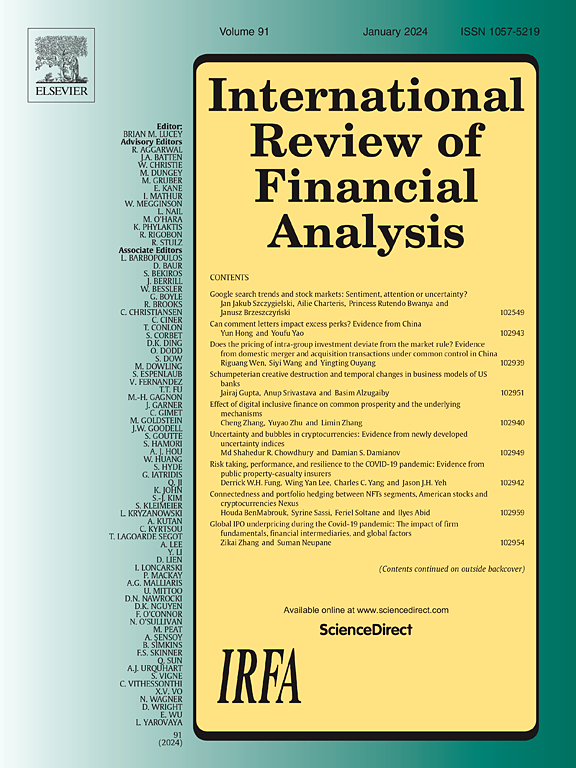重大事件冲击下中国股市行业协会网络的结构演化——基于部分格兰杰因果网络的两次危机比较分析
IF 9.8
1区 经济学
Q1 BUSINESS, FINANCE
引用次数: 0
摘要
本文基于行业间部分格兰杰因果网络模型,探讨了中国股票市场重大事件对行业协会的动态影响机制和风险传导模式。对2015年股市崩盘和COVID-19大流行两个阶段的数据进行比较分析,得出了三个关键结论。首先,市场脆弱性在危机期间表现出显著的异质性。在2015年股灾期间,行业网络密度下降,中心位置从金融行业转向防御性行业。相比之下,在大流行期间,出现了一个以计算机和非银行金融机构为核心的信息中心网络,突显了技术部门在危机期间的资源控制能力。二是风险传导路径发生结构性转变。向外相关分析显示,房地产产业链受益于股市崩盘后的逆周期调控政策,而电子行业的影响在疫情期间飙升。同时,向内强度分析表明,在两次危机中,汽车行业是最大的风险接受者。最后,网络稳定性明显减弱。基序分析显示,危机前和危机期间,所有五个关键的三元和二次结构分别下降了38.5%和49.6%,其中反馈回路基序的下降幅度最大。这证实了重大事件通过削弱因果联系放大了市场的脆弱性。这些发现为网络动力学提供了新的证据,为资本市场极端事件的多米诺骨牌效应提供了有价值的见解。本文章由计算机程序翻译,如有差异,请以英文原文为准。
Structural evolution of industry association networks in Chinese stock market under major event shocks: A comparative analysis of two crises based on partial Granger causal networks
Based on the inter-industry partial Granger causality network model, this study explores the dynamic impact mechanisms and risk transmission patterns of major events on industry associations in the Chinese stock market. A comparative analysis of data from the 2015 stock market crash and the two phases of the COVID-19 pandemic reveals three key findings. First, market vulnerability exhibits significant heterogeneity during crises. During the 2015 stock market crash, industry network density declined, and centrality shifted from the financial sector to defensive industries. In contrast, during the pandemic, an information hub network emerged, with computers and non-banking financials at its core, highlighting the technology sector’s resource control capacity during crises. Second, the risk transmission path underwent a structural shift. Outward correlation analysis shows that the real estate industry chain benefited from counter-cyclical control policies following the stock market crash, while the influence of the electronics industry surged during the pandemic. Meanwhile, inward intensity analysis identifies the automobile industry as the largest risk recipient in both crises. Finally, network stability weakened significantly. Motif analysis comparing pre-crisis and during-crisis periods reveals that all five key triadic and quadratic structures declined by 38.5% and 49.6%, respectively, with feedback loop motifs experiencing the largest reduction. This confirms that major events amplify market vulnerability by weakening causal linkages. These findings provide new evidence on network dynamics, offering valuable insights into the domino effect of extreme events in capital markets.
求助全文
通过发布文献求助,成功后即可免费获取论文全文。
去求助
来源期刊

International Review of Financial Analysis
BUSINESS, FINANCE-
CiteScore
10.30
自引率
9.80%
发文量
366
期刊介绍:
The International Review of Financial Analysis (IRFA) is an impartial refereed journal designed to serve as a platform for high-quality financial research. It welcomes a diverse range of financial research topics and maintains an unbiased selection process. While not limited to U.S.-centric subjects, IRFA, as its title suggests, is open to valuable research contributions from around the world.
 求助内容:
求助内容: 应助结果提醒方式:
应助结果提醒方式:


